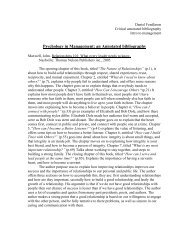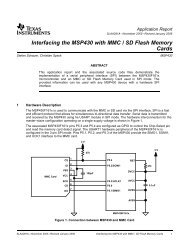Analog Circuit Design Laboratory Report - MyWeb at WIT ...
Analog Circuit Design Laboratory Report - MyWeb at WIT ...
Analog Circuit Design Laboratory Report - MyWeb at WIT ...
You also want an ePaper? Increase the reach of your titles
YUMPU automatically turns print PDFs into web optimized ePapers that Google loves.
EVALUATING OPERATIONAL AMPLIFIERS INCLUDING BASIC<br />
CHARACTERISTICS, USE AS VOLTAGE COMPARATORS, CLOSED LOOP AND<br />
DIFFERENTIAL AMPLIFIERS AND IN SIGNAL CONDITIONING DESIGN<br />
1<br />
Whitney Brown<br />
Portia Lane<br />
Adam Ysasi<br />
October 21, 2005
Objectives<br />
• Measure basic op-amp characteristics including ± VSAT, Iload, Isupply, and shortcircuit<br />
current ±ISC<br />
• Simul<strong>at</strong>e op-amp characteristic measurements using PSpice<br />
• Gener<strong>at</strong>e VO versus time graph and transfer function of non-inverting voltage<br />
compar<strong>at</strong>or<br />
• <strong>Design</strong> and test voltage compar<strong>at</strong>or with bipolar voltage reference<br />
• Connect LED’s to voltage compar<strong>at</strong>or output to identify output current direction<br />
• <strong>Design</strong> and analyze inverting and non-inverting amplifiers with neg<strong>at</strong>ive feedback<br />
• Simul<strong>at</strong>e measurements of three op-amp configur<strong>at</strong>ions using PSpice<br />
• Measure closed-loop voltage gain ACL and phase shift θ between input and output<br />
voltages for inverting and non-inverting amplifiers<br />
• Measure and calcul<strong>at</strong>e basic characteristics of differential amplifier including<br />
differential gain ADIFF, common mode gain ACM, and common mode rejection<br />
r<strong>at</strong>io CMRR<br />
• Build and test discrete three-op-amp instrument<strong>at</strong>ion amplifier<br />
• Add offset voltage to reference terminal of instrument<strong>at</strong>ion amplifier<br />
• Test characteristics of AD620 instrument<strong>at</strong>ion amplifier from <strong>Analog</strong> Devices,<br />
Inc.<br />
• Gener<strong>at</strong>e system equ<strong>at</strong>ion for weight measurement system<br />
• Gener<strong>at</strong>e linear performance equ<strong>at</strong>ion for commercial load cell<br />
• Gener<strong>at</strong>e SCC design equ<strong>at</strong>ion to convert load cell output for input into<br />
microcontroller<br />
• Build, test, and calibr<strong>at</strong>e complete weight measurement system<br />
Discussion of Theory<br />
Oper<strong>at</strong>ional amplifiers or op-amps were originally built with discrete transistors and<br />
resistors, and were named after their first uses of m<strong>at</strong>hem<strong>at</strong>ical oper<strong>at</strong>ions (add, subtract,<br />
multiply, divide, integr<strong>at</strong>e, differenti<strong>at</strong>e etc.) Today they are built as integr<strong>at</strong>ed circuits<br />
(IC) and are used for applic<strong>at</strong>ions th<strong>at</strong> encompass the spectrum of electronics from signal<br />
conditioning to signal gener<strong>at</strong>ion. One reason for their high usage in circuit design is the<br />
tendency of op-amp characteristics to act <strong>at</strong> levels quite close to those predicted<br />
theoretically, th<strong>at</strong> is the characteristics of an op-amp perform close to the assumed ideal. 1<br />
1 Smith, Sedra. Microelectronic CIRCUITS. Oxford University Press, New York, 1982. Pg. 63-64.<br />
2
The ideal op-amp generally has 5 terminals, two input terminals (pins 2 and 3),<br />
one output terminal (pin 6), and two power supply terminals (pins 7 and 4), see Figure 1.<br />
Pin 2 is the inverting input terminal while pin 3 is the non-inverting input terminal. The<br />
power supply terminals are typically connected to a positive voltage, VCC= 15V and to a<br />
neg<strong>at</strong>ive voltage, VEE= -15V, pins 7 and 4 respectively. The characteristics of an ideal<br />
op-amp are th<strong>at</strong> it has an infinite open-loop gain (AOL), an infinite bandwidth (Bwl),<br />
infinite input impedance (Rin), zero output impedance (RO) and zero common-mode gain<br />
(ACM).<br />
When oper<strong>at</strong>ing in its simplest form, displayed in Figure 1, with RL equal to 10-<br />
kΩ (typ), the voltage output of the op-amp is equivalent to the positive or neg<strong>at</strong>ive<br />
s<strong>at</strong>ur<strong>at</strong>ion voltage. The s<strong>at</strong>ur<strong>at</strong>ion voltage (Vs<strong>at</strong>) can be calcul<strong>at</strong>ed by:<br />
+ s<strong>at</strong> = CC −1<br />
V V or 1 + = s<strong>at</strong> EE V V Eq. (1)<br />
The supply current (Isupply), <strong>at</strong> pins 7 and 4 is determined by the supply manufacturer’s<br />
specific<strong>at</strong>ion and ranges from a few milliamps for older products to mega-amps for<br />
today’s new technology. Using Kirkoff’s current law Isupply(+) is equal to Isupply(-) plus the<br />
output current of the op-amp read c′-c, see Figure 1.<br />
I +<br />
sup ply = I ply − I<br />
( + ) sup ( ) o<br />
Eq. (2)<br />
3
Figure 1- Basic Op-amp<br />
When a load resistor value is connected to the output terminal of the op-amp, as<br />
displayed in Figure 1, the op-amp can either be “sourcing” or “sinking” current. When<br />
the op-amp is sinking current, this output current is being delivered by the neg<strong>at</strong>ive<br />
power supply (VEE) and the output voltage will be -Vs<strong>at</strong>. The op-amp sinks a load current<br />
when the direction of the current is from c′ to c and RL has a neg<strong>at</strong>ive voltage drop across<br />
it. The op-amp is sourcing current when the supply current is being delivered by the<br />
positive power supply (VCC) and the output voltage will be a +Vs<strong>at</strong>. When the op-amp<br />
sources a load current the direction of the current is from c to c′ and RL has a positive<br />
voltage drop across it. When the load resistor is very small, a few hundred Ω, the op-amp<br />
goes into short-circuit protection. The typical value of short-circuit current, ISC, for the<br />
741 op-amp is 25mA.<br />
One characteristic of an ideal op-amp is th<strong>at</strong> it has an infinite open-loop gain<br />
(AOL). The typical value for a 741 op-amp is AOL equals 200,000 (200k). The single-<br />
4
ended output voltage Vo is equal the product of the open-loop gain and the differential<br />
voltage, Ed, between pins 2 and 3. The differential voltage, Ed, is equal to the positive<br />
input voltage minus the neg<strong>at</strong>ive input voltage and it controls the polarity of the output<br />
VO. When Ed is positive VO is positive, and when Ed is neg<strong>at</strong>ive VO is neg<strong>at</strong>ive.<br />
V = A E<br />
Eq. (3)<br />
O<br />
OL<br />
5<br />
d<br />
Ed = V ( + ) ⊥ −V<br />
( −)<br />
⊥<br />
Eq. (4)<br />
One function of the op-amp is as a voltage compar<strong>at</strong>or, see Figure 2.<br />
When an AC voltage source, Ei, is connected to the positive input, pin 3, the op-amp is<br />
working as a non-inverting voltage compar<strong>at</strong>or. If the neg<strong>at</strong>ive input, pin 2, is connected<br />
directly to ground, the reference voltage Vref is equal to 0V.<br />
Figure 2- Voltage Compar<strong>at</strong>or<br />
As Ei crosses Vref, going from positive to neg<strong>at</strong>ive, the polarity of VO reverses and<br />
VO changes from +Vs<strong>at</strong> to –Vs<strong>at</strong>. When Ei again crosses Vref, neg<strong>at</strong>ive to positive, VO goes<br />
from –Vs<strong>at</strong> to +Vs<strong>at</strong>. When the voltage source is connected to the neg<strong>at</strong>ive input, pin 2,
the op-amp is working as an inverting compar<strong>at</strong>or where when Ei crosses Vref, neg<strong>at</strong>ive to<br />
positive, VO is inverted and goes from +Vs<strong>at</strong> to –Vs<strong>at</strong>. When Ei crosses Vref, positive to<br />
neg<strong>at</strong>ive, VO is inverted and goes from –Vs<strong>at</strong> to +Vs<strong>at</strong>. Voltage compar<strong>at</strong>ors can be used in<br />
many applic<strong>at</strong>ions such as zero-crossing detectors.<br />
Another important function of the op-amp is as a voltage amplifier. There are<br />
three main circuits th<strong>at</strong> define many of the amplific<strong>at</strong>ion uses of the op-amp. They are an<br />
inverting amplifier, non-inverting amplifier, and a voltage follower. All of these circuits<br />
work off of the of the ideal circuit function of an op-amp. 2<br />
As previously discussed, the basic circuit function of the ideal op-amp is to sense<br />
a differential voltage, Ed, between the voltage inputs signals applied to the op-amp’s two<br />
input terminals 3 . These two inputs have the characteristic of infinite resistance ideally,<br />
meaning th<strong>at</strong> there is no current entering their terminals. The voltage output is the<br />
product of the differential voltage multiplied by the open loop gain, AOL, which for an<br />
ideal op-amp is considered to be infinite.<br />
These two main circuit functions of AOL and Ed combine to be known as a<br />
differential-input single-ended-output amplifier. However, the idea of an infinite gain is<br />
not practical and the op-amp will never be used alone for this reason. The op-amp is<br />
combined with additional passive components in a feedback circuit to provide a finite<br />
gain, known as the closed-loop gain, ACL. The finite gain can be manipul<strong>at</strong>ed to<br />
ultim<strong>at</strong>ely produce a variety of applicable functioning circuits, specifically the inverting<br />
amplifier, the non-inverting amplifier and the voltage follower.<br />
2 Ibid Pg. 65<br />
3 Ibid Pg.65<br />
6
Neg<strong>at</strong>ive feedback occurs when the output is returned to the neg<strong>at</strong>ive input. It<br />
can be used to reverse the direction of change. In amplifiers when the output is fed back<br />
to the neg<strong>at</strong>ive input, the inverted distortions cancel out the distortions produced by the<br />
amplifier itself. In an op-amp circuit neg<strong>at</strong>ive feedback exists if a connection is between<br />
the output terminal (pin 6) and the inverting input terminal (pin 2). This connection can<br />
be may be made with anything th<strong>at</strong> supports a DC current including a wire, resistor, or<br />
b<strong>at</strong>tery. Three basic assumptions are used when explaining the effects of neg<strong>at</strong>ive<br />
feedback. First, the bias current for both the inverting and non-inverting inputs is equal<br />
to zero. Second, the differential voltage Ed is approxim<strong>at</strong>ely 0V. Finally, the voltage on<br />
the non-inverting input with respect to ground is equal to the voltage on the inverting<br />
input with respect to ground.<br />
The inverting amplifier produces an output voltage, see Equ<strong>at</strong>ion 5, which is<br />
equal to the input voltage Vin times by the closed-loop gain, ACL, given in Equ<strong>at</strong>ion 5. The<br />
ACL is derived from Equ<strong>at</strong>ion 5 on principals of Ohm’s Law, see Equ<strong>at</strong>ion 6. A voltage<br />
source is connected to the op-amp’s inverting input, (pin 2) and is grounded <strong>at</strong> the non-<br />
inverting input (pin 3), see Figure 3.<br />
V out ACL<br />
∗VDIFF<br />
. Input<br />
1<br />
= Eq. (5)<br />
V = I ∗ R<br />
Eq. (6)<br />
1<br />
7<br />
1
Figure 3- Inverting Amplifier<br />
The closed loop finite gain, ACL, is possible when the input resistance and the<br />
neg<strong>at</strong>ive feedback resistance are connected between the output and the inverting voltage<br />
source. From a virtual ground cre<strong>at</strong>ed by the sensed difference between the op-amp’s<br />
inputs, a node equ<strong>at</strong>ion can be made based on Kirchoff’s Current Law, as st<strong>at</strong>ed below:<br />
All currents entering a node equal the sum of currents leaving a node.<br />
From this equ<strong>at</strong>ion, the feedback resistor, Rf, acquires a current with equal and opposite<br />
value of the current across the input resistor, Rin, driven by the input source. Only these<br />
two currents are involved in the node equ<strong>at</strong>ion because the inverting input pin takes no<br />
current due to its ideally infinite resistance. The current across Rin and Rf must then be<br />
equal. Because of the virtual ground VO is equal to the voltage drop across Rf. Therefore<br />
the ACL can be written as shown in Equ<strong>at</strong>ion 7. The gain is a result of neg<strong>at</strong>ive feedback.<br />
A<br />
− R<br />
= Eq. (7)<br />
f<br />
CL Rin<br />
8
The non-inverting amplifier works similarly to the inverting amplifier. The non-<br />
inverting amplifier has a different neg<strong>at</strong>ive feedback loop by removing the source <strong>at</strong> the<br />
inverting pin. Thus changes the direction of the current across Rf, see Figure 4.<br />
Figure 4- Non-inverting Amplifier<br />
The inverting pin, now grounded, allows for Rin current and Rin voltage to be determined<br />
since a virtual ground is cre<strong>at</strong>ed with respect to Vin and an Ed of zero. This is also due to<br />
the inverting pin taking on no current due to its infinite resistance. The Rf current can<br />
then be found from Kirchoff’s Current Law because it is the only other current involved<br />
with the known current <strong>at</strong> Rin meeting <strong>at</strong> the virtual ground node. The direction of current<br />
flow there shows RF supplying the current to Rin. The gain equ<strong>at</strong>ion for the non-inverting<br />
9
amplifier is given in Equ<strong>at</strong>ion 8 and is now based on the non-inverting amplifier neg<strong>at</strong>ive<br />
feedback loop.<br />
R f A = + 1<br />
Eq. (8)<br />
CL Rin<br />
The voltage follower circuit is an exploit<strong>at</strong>ion of the inverting and non-inverting<br />
amplifiers’ characteristics. It specifically dwells on the non-inverting amplifier’s ability<br />
to source a voltage with infinite resistance and the idea of neg<strong>at</strong>ive feedback to the<br />
inverting input. The voltage follower, also known as a buffer or isol<strong>at</strong>ion amplifier, is<br />
shown in Figure 5.<br />
Figure 5- Voltage Follower Amplifier<br />
The buffer amplifier is capable of delivering a voltage, with out loss or gain, to a<br />
previously non-excepting load. The buffer must be present to condition the high<br />
impedance voltage source for the load.<br />
10
In associ<strong>at</strong>ion with the non-inverting amplifier characteristics, VO is equal to the<br />
Vin since Ed is equal to zero. This configur<strong>at</strong>ion further allows VO to equal Vin since the<br />
inverting pin source, the Rin and the Rf are not present, allowing non-inverting neg<strong>at</strong>ive<br />
feedback and an ACL equal to 1.<br />
Another op-amp configur<strong>at</strong>ion is the differential amplifier as shown in Figure 6.<br />
In this configur<strong>at</strong>ion the common mode voltage ECM is rejected by the op-amp.<br />
Figure 6– Differential Amplifier<br />
The differential gain, ADIFF, is equal to r<strong>at</strong>io of the resistances R and mR as shown in<br />
equ<strong>at</strong>ion 9, and the output voltage is equal to this gain times the input differential voltage<br />
as given in equ<strong>at</strong>ion 10.<br />
ADIFF = mR / R Eq. (9)<br />
VO = ADIFF * (E1 – E2) Eq. (10)<br />
11
One characteristic of differential amplifiers is the common mode gain ACM. Ideally, the<br />
output voltage should be zero when E1 and E2 are connected to the same terminal, so ACM<br />
should also be zero. This value is a measure of the op-amp quality and is equal to the<br />
common mode output voltage VOCM divided by the common mode voltage ECM as given<br />
in equ<strong>at</strong>ion 11.<br />
ACM = VOCM / ECM Eq. (11)<br />
Determining the common mode voltage gain is necessary to calcul<strong>at</strong>e the common mode<br />
rejection r<strong>at</strong>io CMRR. CMRR is the differential voltage gain ADIFF divided by the<br />
common mode voltage gain ACM as given in equ<strong>at</strong>ion 12 and ideally should be infinite.<br />
Because the value is so large the CMRR is generally given in decibels (dB). CMRR can<br />
be converted to CMRR(dB) using equ<strong>at</strong>ion 13.<br />
CMRR = ADIFF / ACM Eq. (12)<br />
CMRR(dB) = 20 log CMRR Eq. (13)<br />
An amplifier similar to the differential amplifier is the instrument<strong>at</strong>ion amplifier<br />
shown in Figure 7. The pin configur<strong>at</strong>ion for this amplifier is like th<strong>at</strong> of am op-amp<br />
except th<strong>at</strong> the differential voltage gain, ADIFF, is determined by the r<strong>at</strong>io of the resistance<br />
Rg connected between pins 1 and 8 and the internal resistance. Also a reference voltage<br />
can be connected through pin 5.<br />
12
Figure 7– Instrument<strong>at</strong>ion Amplifier<br />
The r<strong>at</strong>io of the resistances, referred to as “a,” is given in Equ<strong>at</strong>ion 14. This value is then<br />
used the calcul<strong>at</strong>e ADIFF using Equ<strong>at</strong>ion 15.<br />
a = aR / R = Rg / R Eq. (14)<br />
ADIFF = 1 + 2 / a Eq. (15)<br />
Output voltage VO for the instrument<strong>at</strong>ion amplifier, given in Equ<strong>at</strong>ion 16, is equal to the<br />
differential voltage gain ADIFF times the voltage difference across the input terminals plus<br />
the reference voltage.<br />
VO = ADIFF *(E1 – E2) + Vref Eq. (16)<br />
The op-amp with its many configur<strong>at</strong>ions can be combined and used in several<br />
applic<strong>at</strong>ions of signal conditioning circuit design. Some applic<strong>at</strong>ions th<strong>at</strong> use a<br />
combin<strong>at</strong>ion of op-amp functions are a microprocessor-based d<strong>at</strong>a acquisition system,<br />
13
which converts pressure into a single ended voltage, a semiconductor diode based sensor<br />
system to measure an input temp and output a voltage, and a human engineered weight<br />
measurement system th<strong>at</strong> accepts an input weight and outputs a single-ended voltage.<br />
The system design process incorpor<strong>at</strong>es first describing m<strong>at</strong>hem<strong>at</strong>ically, from the<br />
st<strong>at</strong>ement of the problem, the system to be designed in the standard form 4 :<br />
y = mx + b<br />
Eq. (17)<br />
The linear performance equ<strong>at</strong>ion of the property being measured is calcul<strong>at</strong>ed using d<strong>at</strong>a<br />
measured from the device and put into the standard form of Equ<strong>at</strong>ion 17. The signal<br />
condition circuit equ<strong>at</strong>ion is then determined by the desired output verse the input<br />
calcul<strong>at</strong>ed from the performance equ<strong>at</strong>ion of the device, and put in the standard form of<br />
Equ<strong>at</strong>ion 17. Its characteristics and wide range of functions make the op-amp one of the<br />
fundamental building blocks of circuit design.<br />
Measuring ± VSAT:<br />
Using the LM741 op-amp, whose package can be seen in Figure 1, a configur<strong>at</strong>ion is<br />
wired with two DC power supplies and no output load. One supply power source of<br />
+15V was connected to pin 7 and the second supply power source of -15V was connected<br />
to pin 4. The total potential across these power supplies was measured <strong>at</strong> 30V. Pin 3, also<br />
known as the non-inverting input, was wired to the positive power supply of +15V.<br />
The ±Vs<strong>at</strong> was expected to measure ± 14V; see Equ<strong>at</strong>ion 1. The + Vs<strong>at</strong> was<br />
measured <strong>at</strong> +14.3V and – Vs<strong>at</strong> was measured <strong>at</strong> -13.63V. This measured loss compares<br />
4 Villanucci, Robert. Wentworth Institute of Technology, Electromechanical Engineering. <strong>Labor<strong>at</strong>ory</strong><br />
Exercise Five Handouts.<br />
14
favorably both voltages being within 10% of expected; where the positive supply had a<br />
percent difference of 2.14% and the neg<strong>at</strong>ive supply had a percent difference of 2.64%.<br />
Input pins 2 and 3, were shorted by connecting them both to ground. From the<br />
d<strong>at</strong>a sheet of the op-amp, the AOL is 200, 000 typically. This was then used to calcul<strong>at</strong>e<br />
the Vout based on Equ<strong>at</strong>ion 3, where Ed is equal to the voltage differential across the<br />
inputs. Here, since the inputs have been shorted, Ed is equal to 0V. However, when VOUT<br />
was measured a reading of 14.3V.<br />
This exercise was simul<strong>at</strong>ed in PSpice. This was devised with simul<strong>at</strong>ed<br />
components and adjacent voltage supplies connected by assigning the same name of the<br />
source <strong>at</strong> the inputs.<br />
Figure 8- Positive Vs<strong>at</strong><br />
15
Figure 9- Neg<strong>at</strong>ive Vs<strong>at</strong><br />
Positive Vs<strong>at</strong> was obtained almost m<strong>at</strong>ching the measured values from the<br />
experiment, seen in Figure 8. Neg<strong>at</strong>ive Vs<strong>at</strong> was similarly taken from PSpice with an<br />
acceptable value, see Figure 9.<br />
Measuring Both Load and Supply Current:<br />
The second circuit configur<strong>at</strong>ion was wired as shown in Figure 1 with no load resistance.<br />
The supply currents are from the two separ<strong>at</strong>e power sources. Isupply(+) was measured <strong>at</strong><br />
0.66mA and Isupply(-) was measured <strong>at</strong> 0.662mA. These values were well within the d<strong>at</strong>a<br />
sheet typical Isupply value of 1.7mA. The difference in ± Isupply is acceptable because the<br />
op-amp is still within manufacturer’s specific<strong>at</strong>ions and the op-amp running <strong>at</strong> this lower<br />
current will run cooler than it would if equal to the specific<strong>at</strong>ions.<br />
16
The next configur<strong>at</strong>ion, with a 10-kΩ load resistor connected to pin 6, illustr<strong>at</strong>es<br />
sourcing current. Sourcing current used the positive supply to feed the output and an<br />
additional source is connected to the non-inverting pin 3. Isupply(+) is equal to the sum of<br />
the neg<strong>at</strong>ive supply current and the current; see Equ<strong>at</strong>ion 2. This s<strong>at</strong>isfied Kirchoff’s<br />
Current Law.<br />
Isupply(+) enters into the op-amp, and I supply(-) and the load current, IL, exit the op-<br />
amp. The circuit was broken so th<strong>at</strong> current measurements could be taken for Isupply(-), Iout<br />
and Isupply(+). The sum of Isupply(-) equal to 0.6mA and IL equal to 1.44mA was within 1.4%<br />
of the direct measurement of Isupply(+) equal to 2.13mA. The polarity of the source current<br />
proved th<strong>at</strong> the op-amp was sourcing current to the load as it was positive and equal to<br />
+Vs<strong>at</strong>.<br />
Next, the circuit was configured to sink current. With the 5V source <strong>at</strong> the<br />
connected to the inverting pin 2, the output became -Vs<strong>at</strong>, since voltage follows from<br />
higher to lower potential, the load current is drawn into the op-amp. The op-amp was<br />
then sinking an IL equal to 1.37mA and using the measured value Isupply(+) <strong>at</strong> 0.6mA from<br />
this circuit, to calcul<strong>at</strong>e an Isupply(-) equal to 2.31mA from Equ<strong>at</strong>ion 2.<br />
Based on the sum of Isupply(+) and Iout when compared to the direct current reading<br />
of Isupply(-) provided a percent difference of 12.26%, which is not within the excepted<br />
10%. Sinking current to the load did provide a –Vs<strong>at</strong>.<br />
This exercise was also simul<strong>at</strong>ed on PSpice, see Figure 10. This was devised with<br />
simul<strong>at</strong>ed components and adjacent voltage supplies connected by assigning the same<br />
name of the source <strong>at</strong> the inputs. The results of PSpice were close to those measured in<br />
17
the lab and clearly demonstr<strong>at</strong>e the principal of Equ<strong>at</strong>ion 2; values are noted on Figure<br />
10.<br />
Short-<strong>Circuit</strong> Current Measurements:<br />
Figure 10- Iload and Isupply<br />
The d<strong>at</strong>a sheet gave a typical value for short circuit current of ± 25mA. The circuit was<br />
wired to source current to the load of very small resistance. The small resistance triggers<br />
the short circuit protection so th<strong>at</strong> the op-amp is not damaged. Positive Isc was achieved <strong>at</strong><br />
an acceptable value of 29mA. When configured for sinking current a neg<strong>at</strong>ive Isc acted<br />
across the load and was measured <strong>at</strong> an acceptable value of -23.9mA.<br />
This was also done in a PSpice simul<strong>at</strong>ion, see Figure 11. This was devised with<br />
simul<strong>at</strong>ed components and adjacent voltage supplies connected by assigning the same<br />
name of the source <strong>at</strong> the inputs.<br />
18
Figure 11- Positive Isc <strong>at</strong> approxim<strong>at</strong>ely maximum<br />
PSpice used the maximum d<strong>at</strong>a sheet characteristics for short circuit current, where<br />
Isc(MAX) was approxim<strong>at</strong>ely 40mA for temper<strong>at</strong>ures above room temper<strong>at</strong>ure. Here it also<br />
demonstr<strong>at</strong>ed the principal th<strong>at</strong> Vo can be brought down lower th<strong>at</strong> s<strong>at</strong>ur<strong>at</strong>ed voltage<br />
when load resistance is very low and Isc protection is turned on.<br />
VO vs. Time and VO vs. Ei for Non-inverting Zero-Crossing Detector:<br />
Using the 741 op-amp, the circuit is setup as shown in Figure 12. VCC of 15V and VEE of<br />
-15V are applied to the op-amp prior the applying the voltage Ei. Ei is then set to a ± 10V<br />
(peak) triangle wave <strong>at</strong> a frequency of 50 Hz on the waveform gener<strong>at</strong>or.<br />
19
Figure 12 – Non-inverting zero-crossing detector<br />
Channel 1 of the oscilloscope is used to read Ei and channel 2 to read VO. The<br />
oscilloscope is set to dc coupling mode. Figure 13 displays the plot of VO versus time.<br />
+Vs<strong>at</strong> measures 13.13V and –Vs<strong>at</strong> measures -13.44V. Since the neg<strong>at</strong>ive input (pin 2) is<br />
connected directly to ground, the reference voltage Vref is equal to 0V. As Ei crosses Vref,<br />
going from positive to neg<strong>at</strong>ive, the polarity of VO reverses and VO changes from +Vs<strong>at</strong> to<br />
–Vs<strong>at</strong>. When Ei again crosses Vref, neg<strong>at</strong>ive to positive, VO goes from –Vs<strong>at</strong> to +Vs<strong>at</strong>.<br />
20
Figure 13– Plot of Ei versus time and VO versus time<br />
After grounding both oscilloscope channels and zeroing the electron beam to the center<br />
of the scope face, the oscilloscope is set to display the transfer function for the voltage<br />
compar<strong>at</strong>or as shown in Figure 14.<br />
Figure 14– Plot of VO versus Ei<br />
21
+Vs<strong>at</strong> measures 14.06 V and –Vs<strong>at</strong> measures -12.66 V. These values differ slightly than<br />
recorded previously because of the channels being grounded. This transfer function is<br />
indic<strong>at</strong>ive of a non-inverting compar<strong>at</strong>or. The polarity of Ei and VO are always equal.<br />
<strong>Design</strong> and Testing of a Voltage Compar<strong>at</strong>or:<br />
Figure 15 is the transfer function for an inverting voltage compar<strong>at</strong>or. From this plot<br />
+Vs<strong>at</strong>, -Vs<strong>at</strong>, VCC, VEE, + Ei (peak), - Ei (peak), and Vref can all be determined. +Vs<strong>at</strong><br />
equals 12.5V. –Vs<strong>at</strong> equals -12.5V. Because Vs<strong>at</strong> is approxim<strong>at</strong>ely 1V less than the<br />
power supply voltage, VCC is 13.5V and VEE is -13.5V. +Ei is 7.5V and -Ei is -7.5V.<br />
Because the output polarity changes <strong>at</strong> 0V, Vref is 0V.<br />
Figure 15 – Transfer Function<br />
22
Using the inform<strong>at</strong>ion derived from Figure 5, an inverting voltage compar<strong>at</strong>or is designed<br />
as shown in Figure 16. After applying dc power, Ei is adjusted to a ±7.5 V, 50Hz triangle<br />
wave.<br />
Figure 16 – Inverting voltage compar<strong>at</strong>or<br />
Using the oscilloscope, channel 1 is set to measure the input voltage <strong>at</strong> pin 2. Channel 2<br />
measures the voltage across the load resistance RL. Figure 17 displays these voltages<br />
versus time. +Vs<strong>at</strong> measures +12.50V and –Vs<strong>at</strong> measures -11.44V.<br />
23
Figure 17 - Plot of Ei versus time and VO versus time<br />
In Figure 7, VO and Ei cross p<strong>at</strong>hs <strong>at</strong> a value of 0V. Therefore Vref has a value of 0V. As<br />
Ei crosses Vref and goes above it, the VO polarity reverses and it switches from +Vs<strong>at</strong> to –<br />
Vs<strong>at</strong>. The opposite occurs when Ei again crosses Vref going below it. The polarity again<br />
reverses, changing from –Vs<strong>at</strong> to +Vs<strong>at</strong>. By changing the oscilloscope’s time base to XY,<br />
the plot of VO versus Ei is cre<strong>at</strong>ed as shown in Figure 18.<br />
Figure 18 - Plot of VO versus Ei<br />
24
The output voltage can be altered so th<strong>at</strong> it is not always ±Vs<strong>at</strong>. VO can be reduced to<br />
approxim<strong>at</strong>ely 5V by reducing the load resistance RL. If the load resistance is low<br />
enough the op-amp will enter a st<strong>at</strong>e of short circuit protected in which the current ISC is<br />
typically ±25mA. If the 10-kΩ load resistor is replaced by a 220-Ω resistor, VO equals<br />
3.75V as shown on Figure 19.<br />
Figure 19 - Plot of Ei versus time and VO versus time<br />
Adding LEDs to the output Terminal of an Op-amp:<br />
The compar<strong>at</strong>or test circuit is wired as shown in Figure 20. R2 is a potentiometer with a<br />
range of 0 to 10-kΩ . R2 is adjusted so th<strong>at</strong> the green LED is in the “on” position and the<br />
red LED is in the “off” position.<br />
25
Figure 20 – Test <strong>Circuit</strong><br />
VO, VLED(F) (green), and VLED(R) (red) are measured using the DMM. All three voltages<br />
are equal and measure 2.08V. The output current IO of the op-amp is measured to be<br />
16.8mA. This current indic<strong>at</strong>es th<strong>at</strong> the op-amp is in short-circuit protection. The<br />
direction of the current indic<strong>at</strong>es th<strong>at</strong> the op-amp is sourcing current in this configur<strong>at</strong>ion.<br />
The maximum reverse voltage th<strong>at</strong> can occur across the LED before damage occurs is<br />
5V. The “off” LED is protected since the voltage across it was only 2.08V. R2 is then<br />
adjusted until the red LED is in the “on” position and the green LED in the “off” position.<br />
VO, VLED(F) (green), and VLED(R) (red) equal -1.625V. IO equals -14.8mA. The circuit is<br />
again in short-circuit protection. The recommended forward current across the “on” LED<br />
is from 10mA to 25mA. The measured current is therefore acceptable. Damage is not<br />
likely to occur to the LED because current is limited by the op-amp short circuit<br />
protection current.<br />
26
Analysis of an Inverting Amplifier and Measuring its ACL and Phase Shift:<br />
First, construction of the circuit seen in Figure 3 was done using color coded resistor<br />
values of 33-kΩ for Ri and 100-kΩ for Rf. The resistance of Ri was measured to be<br />
32.7-kΩ and Rf was measured to be 99.27-kΩ . A load resistor was added, and proved to<br />
have no effect on the output voltage. The circuit was wired to an input voltage of ±2V <strong>at</strong><br />
100Hz from the function gener<strong>at</strong>or and source voltages of VCC= +15V and VEE= -15V.<br />
The closed loop gain for the inverting amplifier could then be calcul<strong>at</strong>ed based on its gain<br />
equ<strong>at</strong>ion, see Equ<strong>at</strong>ion 7. The ACL was calcul<strong>at</strong>ed to be -3.036.<br />
An oscilloscope was used with channel 1 monitoring the input voltage and<br />
channel two monitoring the output voltage. A picture was taken of the results, see Figure<br />
19. The graph illustr<strong>at</strong>es th<strong>at</strong> when Vi goes positive, VOUT is neg<strong>at</strong>ive, or vise versa. VOUT<br />
is equal to ± Vs<strong>at</strong>, with its polarity dependant on the polarity of Vi.<br />
Figure 19- Oscilloscope picture of inverting amplifier<br />
27
The experiment was then conducted with the input voltage changed from a peak voltage<br />
of 2V to 5V. This change in voltage caused VOUT to be distorted, note the fl<strong>at</strong> toped<br />
wave, see Figure 20. The distortion was due to the voltage being over amplified; being<br />
th<strong>at</strong> the supplied Vi was too high and was producing an output voltage above Vs<strong>at</strong>. Vs<strong>at</strong> is<br />
the maximum output voltage possible from the source voltages of +15V and -15V, the<br />
supply voltage for op-amps. This means th<strong>at</strong> the circuit designer does have limit<strong>at</strong>ions<br />
and its chosen available ±Vs<strong>at</strong> must be considered.<br />
Figure 20- Distortion of output voltage inverting amplifier<br />
Graphical represent<strong>at</strong>ion of the inverting amplifier was achieved through PSpice<br />
simul<strong>at</strong>ion, see Figure 22. The simul<strong>at</strong>ion consisted of virtual components and virtual<br />
voltage sources connected through virtual wire and part name, see Figure 21. The input<br />
voltage was modeled by a sin wave with amplitude equal to an absolute value of Vi. The<br />
output voltage can be seen with an amplified voltage of an absolute value of 5.97V and a<br />
28
180º phase shift from the Vin. The output voltage was within 2% of the calcul<strong>at</strong>ed value<br />
of an absolute value of 6.07V and the phase shift was measured <strong>at</strong> the expected value of<br />
180˚. Based on the measured input and output voltages, the A CL was calcul<strong>at</strong>ed using<br />
Equ<strong>at</strong>ion 7. The measured ACL value was -2.97. This was within 2.16% of our expected<br />
ACL of -3.03.<br />
Figure 21- Analysis of inverting amplifier circuit<br />
29
Voltage (mV)<br />
8<br />
6<br />
4<br />
2<br />
0<br />
-2<br />
-4<br />
-6<br />
-8<br />
Figure 22- Graphical analysis of inverting amplifier<br />
Analysis of a Non-inverting Amplifier and Measuring its ACL and Phase Shift:<br />
First, construction of the circuit seen in Figure 4 was done using color coded resistor<br />
values of 15-kΩ for Ri and 120-kΩ for Rf. The resistance of Ri was measured to be<br />
14.8-kΩ and Rf measured to be 117 -kΩ. A load resister was placed <strong>at</strong> the terminal of the<br />
output voltage, which proved to have no effect on the value of the output voltage. The<br />
circuit was hooked to an input voltage of ±1V <strong>at</strong> 100Hz from the function gener<strong>at</strong>or, and<br />
source voltages of VCC= +15V and VEE= -15V. The closed loop gain for the non-<br />
inverting amplifier was then calcul<strong>at</strong>ed using the gain equ<strong>at</strong>ion, Equ<strong>at</strong>ion 8. The gain for<br />
the non-inverting amplifier was calcul<strong>at</strong>ed to 8.905.<br />
The experiment was conducted with the input voltage changed from a peak<br />
voltage of 2V to 5V. This voltage change caused distortion of the Vout wave as previously<br />
seen with the Inverting Amplifier.<br />
Inverting Amplifier Analysis<br />
Voltage Output<br />
30<br />
Voltage Input
The oscilloscope had the input voltage monitored by channel one and seen<br />
modeled by a sin wave with an amplitude equal to Vin. The output voltage was monitored<br />
by channel 2. Pictures were taken of the results, see Figure 23 and Figure 24.<br />
Figure 23- oscilloscope picture of non-inverting amplifier<br />
Figure 24-Distorted voltage output oscilloscope picture<br />
31
Graphical represent<strong>at</strong>ion of the non-inverting amplifier was achieved through<br />
PSpice simul<strong>at</strong>ion as seen with the inverting amplifiers. A phase shift of zero was noted<br />
and expected. Vout had a peak voltage of an absolute value of 7.94V. This did not<br />
compare favorably and was calcul<strong>at</strong>ed to be within 10.8% of our expected peak output<br />
voltage of 8.905V. PSpice was repe<strong>at</strong>ed for the distortion of the output voltage, see<br />
Figure 25. The graphical represent<strong>at</strong>ion of the distorted non-inverting amplifier output<br />
can be seen in Figure 26 with the same specific<strong>at</strong>ions as the non-distorted non-inverting<br />
amplifier except having too high of an output voltage value.<br />
Figure 25- Analysis of non-inverting amplifier circuit<br />
32
Voltage (V)<br />
8<br />
6<br />
4<br />
2<br />
0<br />
-2<br />
-4<br />
-6<br />
-8<br />
Figure 26- Graphical analysis of distorted output of non-inverting amplifier<br />
Based on the measured input and output voltages, the ACL was calcul<strong>at</strong>ed from Equ<strong>at</strong>ion<br />
8 for a measured ACL value was 7.94, comparing within 10.8% of our expected ACL,<br />
which is an unacceptable percent error of 10%.<br />
Voltage Follower <strong>Circuit</strong> and Measuring its ACL and Phase Shift:<br />
The voltage follower circuit was wired as shown in Figure 5. The Vin was set to ±5V <strong>at</strong><br />
100Hz by the function gener<strong>at</strong>or. An ACL of 1 was expected because the voltage output is<br />
equal to the input voltage for the voltage follower circuit. The ACL was measured <strong>at</strong> 1.007<br />
comparing favorably to the expected value.<br />
Distorted Vout of Non-inverting Amplifier<br />
The oscilloscope monitored the input voltage on channel 1 and the output voltage<br />
on channel 2. A picture was taken of the results, see Figure 27.<br />
33<br />
Voltage Output<br />
Input Voltage
Figure 27 - Voltage follower oscilloscope picture, adjusted to separ<strong>at</strong>e graphs<br />
A PSpice simul<strong>at</strong>ion was conducted to test the results. The configur<strong>at</strong>ion can be<br />
seen in Figure 28, and a graphical represent<strong>at</strong>ion of the voltage follower can be seen in<br />
Figure 29. The graph emphasizes the overlapping voltage waves by having a display th<strong>at</strong><br />
appears as one wave form but is actually the waveform of the input voltage and the<br />
waveform of the output voltage overlapping it.<br />
34
Voltage (V)<br />
6<br />
4<br />
2<br />
0<br />
-2<br />
-4<br />
-6<br />
Figure 28- Analysis of a voltage follower circuit<br />
Voltage Follower Analysis<br />
Figure 29- Graphical analysis of voltage follower<br />
35<br />
Output Voltage<br />
Input Voltage
Differential Voltage Gain:<br />
The circuit was setup as shown in Figure 30 and E1 and E2 were measured with respect to<br />
ground using the DMM. E1 measured 458mV and E2 measured 448mV. The differential<br />
voltage across the 10-Ω resistor (E1-E2) was calcul<strong>at</strong>ed to be 10mV. The common mode<br />
voltage ECM for this circuit was equal to E2, or 448mV.<br />
Figure 30 – Test circuit to measure ADIFF<br />
With resistors mR and R equal to 100-kΩ and 20-kΩ respectively, the differential voltage<br />
gain, ADIFF, was calcul<strong>at</strong>ed using Equ<strong>at</strong>ion 9. Using Equ<strong>at</strong>ion 10, expected output<br />
voltage VO was calcul<strong>at</strong>ed to be 50 mV. Using the DMM VO was measured as 48.39mV.<br />
The percent error between the calcul<strong>at</strong>ed and measured values was 3.6%.<br />
The differential voltage gain can be altered by simply changing the values of the<br />
resistors. To increase ADIFF to 100, resistor mR could be increased to 2-MΩ, or resistor R<br />
36
could be reduced to 1-kΩ. To decrease ADIFF to 1, resistor mR could be decreased to 20-<br />
kΩ, or resistor R could be increased to 100-kΩ.<br />
Measuring Both ACM and CMRR:<br />
The circuit shown in Figure 30 was modified to include a common-mode adjustment as<br />
shown in Figure 31. The positive and neg<strong>at</strong>ive inputs were both connected to E2. E2 was<br />
then the common-mode voltage, ECM. ECM was then measured as 449.7mV.<br />
Figure 31– Test circuit to measure ACM and CMRR<br />
The DMM was connected to the output of the differential amplifier and the 50-kΩ<br />
potentiometer was adjusted until the smallest output voltage was displayed. This output<br />
voltage was recorded as the VOCM and equal to 0.01mV. The common mode voltage gain<br />
37
ACM was then calcul<strong>at</strong>ed using Equ<strong>at</strong>ion 11. ACM equaled 2.23 x10 -5 . The common<br />
mode rejection r<strong>at</strong>io CMRR was then calcul<strong>at</strong>ed using Equ<strong>at</strong>ion 12, and determined to be<br />
225,529. The circuit shown in Figure 31 could be altered to increase and improve the<br />
CMRR by increasing ADIFF as previously discussed.<br />
AD620 Instrument<strong>at</strong>ion Amplifier:<br />
The circuit was setup with the AD620 instrument<strong>at</strong>ion amplifier as shown in Figure 32.<br />
The differential gain ADIFF was set to 10 by adjusting the 10-kΩ potentiometer.<br />
Figure 32 – AD620 Instrument<strong>at</strong>ion Amplifier<br />
E1 was measured as 461mV with respect to ground. E2 was measured as 451mV with<br />
respect to ground. Using Equ<strong>at</strong>ion 10 output voltage VO was predicted to be 100mV. VO<br />
was then measured to be 98.2mV.<br />
38
The 10-kΩ potentiometer was then adjusted for a differential gain ADIFF of 100.<br />
Again using Equ<strong>at</strong>ion 10 VO was predicted to be 1.0 V. VO was measured as 970 mV,<br />
which is within 3% of the predicted value.<br />
The circuit was then modified as shown in Figure 33 to determine the common-<br />
mode voltage gain ACM with both input being connected to E2. ECM, equal to E2, was<br />
then measured to be 452mV. VOCM was then measured as 0.12mV.<br />
Figure 33 – Measurement of CMRR<br />
Using Equ<strong>at</strong>ion 11 ACM was calcul<strong>at</strong>ed to be 6.64 x 10 -6 . CMRR was calcul<strong>at</strong>ed a using<br />
Equ<strong>at</strong>ion 12 to be 150,666. CMRR was then converted to dB units using Equ<strong>at</strong>ion 13.<br />
CMRR(dB) equals 103.5, which is significantly lower than the typical d<strong>at</strong>a sheet value.<br />
The typical d<strong>at</strong>a sheet value shows CMRR(dB) to be 130 when ADIFF is equal to 100.<br />
39
Three-Op-Amp Instrument<strong>at</strong>ion Amplifier:<br />
The circuit was setup as shown in Figure 34. This circuit is a three-op-amp<br />
instrument<strong>at</strong>ion amplifier and acts similarly to the AD620. Op-amps A1 and A2 act as<br />
buffered inputs used to increase input impedance. The differential gain is adjusted by the<br />
aR resistor. VO responds only to EDIFF, (E1- E2).<br />
Figure 34 – Three-Op-Amp Instrument<strong>at</strong>ion Amplifier<br />
Initially the aR resistor was equal to 20-kΩ. Using Equ<strong>at</strong>ion 14 it was calcul<strong>at</strong>ed to be 1.<br />
Using Equ<strong>at</strong>ion 15 ADIFF was calcul<strong>at</strong>ed to be 3. The 10-Ω resistor in the circuit was<br />
actually measured to be 11.7-Ω. From Equ<strong>at</strong>ion 10 the differential output voltage of the<br />
40
input stage VO’ was calcul<strong>at</strong>ed to be 35mV. The differential gain of the output stage was<br />
equal to 1, so the overall circuit was equal to ADIFF and VO was calcul<strong>at</strong>ed to be 35mV.<br />
VO was measured to be 34.9mV. E1 and E2 were measured as 458.9mV and<br />
447.7mV, respectively. Using Equ<strong>at</strong>ion 15 ADIFF was equal to 3.12. Both VO and ADIFF<br />
were within 4% of the calcul<strong>at</strong>ed values.<br />
Resistor aR was then changed to a 100-kΩ resistor to increase the instrument<strong>at</strong>ion<br />
amplifiers differential gain. Using Equ<strong>at</strong>ion 14, a, equals 5, VO’ equals 16.4 mV, and VO<br />
equals 16.4 mV. Using the DMM, VO’ was measured as 15.75 mV, and VO was<br />
measured as 17.0 mV. The DMM was then used to measure E1 and E2. Their values<br />
were 458.9 mV and 447.7 mV, respectively. Using Equ<strong>at</strong>ion 15 ADIFF was calcul<strong>at</strong>ed to<br />
be 1.52. Both VO and ADIFF were within 10% of the calcul<strong>at</strong>ed values.<br />
The differential gain for this circuit could be adjusted to any value by changing<br />
aR. The actual resistor value was determined using Equ<strong>at</strong>ion 14 and Equ<strong>at</strong>ion 15. To<br />
achieve an overall circuit gain of 100, aR must be equal to 404-Ω.<br />
Adding a Voltage to the Reference Terminal:<br />
The reference terminal of the instrument<strong>at</strong>ion amplifier was modified to provide an offset<br />
voltage. This was done by constructing the circuit shown in Figure 35. This circuit was<br />
then connected to the reference terminal of the circuit shown in Figure 35. The<br />
connection between the reference terminal and ground was removed.<br />
41
Figure 35 – Adjustable Reference Voltage, Vref<br />
Power was applied and the 10-kΩ potentiometer was adjusted until reference voltage Vref<br />
equaled 0V. Because the potentiometer only used “one turn,” an exact value of 0V could<br />
not be achieved. Vref was set to 1.5 mV. VO was measured as 18.09 mV. This value<br />
was acceptable to continue.<br />
If Vref were set to any other value, VO would change by the same amount. Vref<br />
was set to 3V. Using Equ<strong>at</strong>ion 16 VO was predicted to be 3.012V. VO was then<br />
measured as 3.0195V. This was within 1% of the calcul<strong>at</strong>ed value. Vref was then<br />
changed to -4V, and VO was again predicted using Equ<strong>at</strong>ion 16 to be 3.988V. VO then<br />
equaled -3.972V. This value was also within 1% of the calcul<strong>at</strong>ed value.<br />
42
Adding Vref to an instrument<strong>at</strong>ion amplifier could be useful in a variety of<br />
applic<strong>at</strong>ions. If a pressure sensor produced an output voltage <strong>at</strong> a pressure considered to<br />
be rel<strong>at</strong>ive zero, Vref could be used to elimin<strong>at</strong>e th<strong>at</strong> offset.<br />
Weight System M<strong>at</strong>hem<strong>at</strong>ical <strong>Design</strong>:<br />
The st<strong>at</strong>ement of the problem was to design a human engineered weight system around<br />
the PLC-5 labor<strong>at</strong>ory load cells. The design requirements were th<strong>at</strong> it must accept weight<br />
as an input, from 0 to 5 pounds, and output a single-ended voltage th<strong>at</strong> varied from 0 to<br />
5000mV (0 to 5V). The first step in the design process was to graph the system, see<br />
Figure 36, and develop the System Equ<strong>at</strong>ion (VO vs. W). The System Equ<strong>at</strong>ion was<br />
determined to be:<br />
V O<br />
= V<br />
Lbs<br />
∗W<br />
1<br />
System Equ<strong>at</strong>ion<br />
0<br />
0 5<br />
Output Voltage (V)<br />
Figure 36- System Equ<strong>at</strong>ion<br />
43<br />
6<br />
5<br />
4<br />
3<br />
2<br />
1<br />
W (lbs)<br />
Eq. (18)
The PLC-5 load cell and weights were then used to take d<strong>at</strong>a to write the Sensor Equ<strong>at</strong>ion<br />
(W vs. VDIFF) for the load cell, see Figure 37.<br />
Sensor Equ<strong>at</strong>ion<br />
0<br />
0 1 2 3 4 5<br />
W (lbs)<br />
Figure 37- Sensor Equ<strong>at</strong>ion<br />
The load cell was powered with +10.0V (red) and connected to ground (black). The<br />
differential output voltage (VDIFF) between the green (+) and white (-) leads was<br />
measured, and a differential voltage of 3.84 mV was measured to be the offset when the<br />
weight to be measured was 0 lbs. The procedure of placing weights on the load cell and<br />
measuring the differential voltage output continued for the range of weights listed in<br />
Table 1.<br />
Measured Weight (g) Measured Weight (lbs) VDIFF (mV)<br />
0g 0 lbs. 3.84 mV<br />
454g 1 lbs. 7.72 mV<br />
908g 2 lbs. 11.59 mV<br />
1361g 3 lbs. 15.61 mV<br />
44<br />
25<br />
20<br />
15<br />
10<br />
5<br />
Voltage Difference (mV)
1851g 4 lbs. 19.74 mV<br />
2268g 5 lbs. 23.33 mV<br />
Table 1- Weight and Differential Voltage<br />
The Sensor Equ<strong>at</strong>ion calcul<strong>at</strong>ed from the end points of 0 and 5 lbs. was determined to be:<br />
V DIFF<br />
= ( 3.<br />
896mV<br />
Lbs<br />
) ∗W<br />
+ 3.<br />
84mV<br />
Eq. (19)<br />
The signal condition circuit (SCC) design was then graphed, see Figure 38. The SCC<br />
<strong>Design</strong> Equ<strong>at</strong>ion needed to signal condition the output of the load cell to produce the<br />
System Equ<strong>at</strong>ion was:<br />
Voltage Output (V)<br />
6<br />
5<br />
4<br />
3<br />
2<br />
1<br />
0<br />
VO DIFF<br />
= 256. 54 ∗V<br />
− 985.<br />
1mV<br />
Eq. (20)<br />
SCC <strong>Design</strong> Equ<strong>at</strong>ion<br />
3.84 23.33<br />
Voltage Difference (mV)<br />
Figure 38- SCC <strong>Design</strong> Equ<strong>at</strong>ion<br />
45
Weight System Hardware <strong>Design</strong>:<br />
The requirements of the design were th<strong>at</strong> the instrument<strong>at</strong>ion amplifier should have a<br />
differential gain, ADIFF, of approxim<strong>at</strong>ely 10 with no offset. The design was constructed<br />
using an AD620 instrument<strong>at</strong>ion amplifier and a 741C op-amp, see Figure 39.<br />
Figure 39- <strong>Circuit</strong> Configur<strong>at</strong>ion of the System<br />
The resistor, Rg, connected to pins 1 and 8 of the AD620, was chosen using the<br />
requirements of ADIFF and Eq. 16. Rg was chosen to be a 499Ω and a 4.99-kΩ resistor in<br />
series.<br />
The feedback resistor, Rf, of the op-amp was chosen to be 100-kΩ. The input resistor, Ri,<br />
was calcul<strong>at</strong>ed using Equ<strong>at</strong>ion 8, where it was set equal to the remaining gain. Ri was<br />
calcul<strong>at</strong>ed to be 2.7k resistor and a 5k potentiometer in series. The offset resistor, Roff, of<br />
the 741C op-amp was calcul<strong>at</strong>ed based on the value of Rf and Vref to s<strong>at</strong>isfy the offset of<br />
the SCC <strong>Design</strong> Equ<strong>at</strong>ion, Equ<strong>at</strong>ion 20. This allowed for Roff to be calcul<strong>at</strong>ed providing<br />
the desired voltage output.<br />
46
Roff was calcul<strong>at</strong>ed to be a 1.2-MΩ resistor and a 1-MΩ potentiometer in series with a<br />
Vref of +15V.<br />
After the circuit was constructed the gain and offset adjustments were calibr<strong>at</strong>ed<br />
using the potentiometers so th<strong>at</strong> <strong>at</strong> 5 Lbs the DMM read 5V and <strong>at</strong> 0 Lbs the DMM read<br />
0V. The circuit was then tested for a weight of 1250 grams. A value of 2.74V was<br />
calcul<strong>at</strong>ed and a value of 2.74V was measured <strong>at</strong> this weight.<br />
Conclusion:<br />
In the op amp’s simplest form, the output voltage will be <strong>at</strong> ±Vs<strong>at</strong>. The voltage output is<br />
determined by the polarity of the differential voltage across the input terminal. For either<br />
differential voltage polarity, the magnitude of VO will be approxim<strong>at</strong>ely1V less than the<br />
power supply voltage, either VCC or VEE. This was demonstr<strong>at</strong>ed when the VCC of +15V<br />
was connected to pin 3. VO was measured <strong>at</strong> an acceptable value for +Vs<strong>at</strong> <strong>at</strong> +14.3V.<br />
Then, when the VEE of -15V was connected to pin 3, the VO was measured <strong>at</strong> an<br />
acceptable value for -Vs<strong>at</strong> <strong>at</strong> -13.63V. Supply current was measured as 0.66mA. This<br />
was not equal to the typical manufacturer specific<strong>at</strong>ion of 1.7mA, but this is considered<br />
beneficial as it allows the op amp to oper<strong>at</strong>e <strong>at</strong> a lower temper<strong>at</strong>ure. This op amp<br />
configur<strong>at</strong>ion was also gener<strong>at</strong>ed in PSpice having the non-inverting pin take the different<br />
supply voltage sources. This gave values th<strong>at</strong> were similar to the measured values.<br />
With a typical resistance value of 10-kΩ connected to the output terminal of the<br />
op amp, a load current is drawn from op amp. This load current varies with the magnitude<br />
of the load resistance. The maximum load current, known as the short circuit current is<br />
typically 25mA. For the op amp tested, the short circuit current was 27mA. Short circuit<br />
47
protection is achieved only with a small resistive load, usually only a few hundred ohms.<br />
Once in short circuit protection, the load resistance can be continually decreased from the<br />
value th<strong>at</strong> caused short circuit protection to give continuously decreasing values for VO<br />
from the ±Vs<strong>at</strong>.<br />
The op amp as a voltage compar<strong>at</strong>or was practiced and illustr<strong>at</strong>ed. The<br />
compar<strong>at</strong>or is defined by the reference voltage and the input taking in the source voltage.<br />
There are two types of compar<strong>at</strong>ors; the first is an inverting compar<strong>at</strong>or where the input<br />
source voltage is placed <strong>at</strong> the inverting pin 2. The other is the non-inverting compar<strong>at</strong>or<br />
where the input source voltage is placed <strong>at</strong> non-inverting pin 3. In both cases the pin not<br />
connected to the source voltage is considered the reference voltage, whether it is<br />
connected to another voltage or to ground. The VO will have the polarity of the input<br />
differential Ed because it is an open-loop circuit. When the VO is high (<strong>at</strong> + Vs<strong>at</strong>) or when<br />
the VO is low (<strong>at</strong> –Vs<strong>at</strong>) is determined by the reference voltage. VO is equal to – Vs<strong>at</strong> when<br />
Ed is neg<strong>at</strong>ive; VO is equal to + Vs<strong>at</strong> when Ed is positive.<br />
For the non-inverting zero-crossing detector analyzed in the labor<strong>at</strong>ory, the<br />
oscilloscope displayed a square wave with peak voltages of ± Vs<strong>at</strong>. With the reference<br />
voltage <strong>at</strong> ground, the output voltage switched polarity as the input voltage crossed the<br />
reference voltage, which was connected to ground. This was exactly as expected for a<br />
non-inverting zero-crossing detector. The output voltage can be adjusted. This is done<br />
by forcing the op amp into short circuit protection. In this experiment the output voltage<br />
VO was reduced to ±3.75V by replacing the 10-kΩ resistor with a 220-Ω resistor. VO can<br />
be changed to any values within ± Vs<strong>at</strong> by adjusting the load resistance.<br />
48
Through the use of neg<strong>at</strong>ive feedback, the op amp can be configured so th<strong>at</strong> VO is<br />
not always in a st<strong>at</strong>e of s<strong>at</strong>ur<strong>at</strong>ion, but r<strong>at</strong>her equal to the value in Equ<strong>at</strong>ion 5. In the<br />
inverting configur<strong>at</strong>ion the closed loop gain, given in Equ<strong>at</strong>ion 7 as the neg<strong>at</strong>ive r<strong>at</strong>io of<br />
the feedback and input resistances, was proven correct as the gain -2.97 was within 2% of<br />
the calcul<strong>at</strong>ed value. Also for the non-inverting and voltage follower configur<strong>at</strong>ions, the<br />
closed loop gains were within 1% of the calcul<strong>at</strong>ed values. Knowing th<strong>at</strong> the op amps so<br />
closely perform according to the theoretical rel<strong>at</strong>ionships allows for easy design of signal<br />
conditioning circuits. To design the proper circuit, given the desired voltage gain, one<br />
may simply choose the feedback resistor value and solve for the input resistance. For<br />
example, to achieve a gain of -5 the designer chooses an inverting configur<strong>at</strong>ion and<br />
feedback resistor of 100-kΩ. The necessary input resistance would be 20-kΩ.<br />
The ADIFF describes the amplific<strong>at</strong>ion amount of the detected voltage difference<br />
between input terminals. This gain results in an output voltage of the difference amplifier<br />
ready for applic<strong>at</strong>ion. This gain value can be controlled by the four resistors, m<strong>at</strong>ching<br />
resistor pair combin<strong>at</strong>ion <strong>at</strong> the differential amplifier inputs. For both the differential and<br />
instrument<strong>at</strong>ion amplifiers the calcul<strong>at</strong>ed and measured values for ADIFF were within<br />
3%.<br />
The ACM is ideally zero since any VCM should have no amplific<strong>at</strong>ion. This is a<br />
tool used to help portray a real difference amplifier’s accuracy. It is responsible in<br />
determining the CMRR, which for an ideal circumstance is infinite. Therefore, as ACM<br />
becomes finite, the CMRR will decrease from the ideal value. For the differential<br />
amplifier the ACM can be regul<strong>at</strong>ed better by using resistor values with much higher<br />
precision. If the CMRR is too low, the differential amplifier will be ineffective since the<br />
49
VDIFF detected will not be accur<strong>at</strong>ely represented by its gain <strong>at</strong> the output if a VCM is<br />
being detected and over amplified.<br />
The CMRR, can be altered by the ADIFF more readily since there is more control<br />
over this th<strong>at</strong> the ACM. This is also reflected in the manufacturer d<strong>at</strong>a sheets, as the<br />
CMMR is listed for different circuit gains ranging logarithmically between 1 and 1000.<br />
This further supports th<strong>at</strong> the CMRR and ADIFF are be design<strong>at</strong>ed by the designer.<br />
In this experiment one applic<strong>at</strong>ion of signal conditioning circuit design was<br />
<strong>at</strong>tempted. The process of designing and developing a circuit applic<strong>at</strong>ion involves first<br />
setting a system equ<strong>at</strong>ion, then calcul<strong>at</strong>ing a sensor equ<strong>at</strong>ion, and finally developing the<br />
signal conditioning circuit design, SCC, equ<strong>at</strong>ion. The design process includes solving<br />
for resistor values to s<strong>at</strong>isfy the desired gain and offset for the output.<br />
The signal conditioning circuit developed in this experiment was successful as an<br />
intermittent weight was chosen and the correct voltage was displayed. This process can<br />
likely be applied to many other applic<strong>at</strong>ions involving circuit design.<br />
50
















